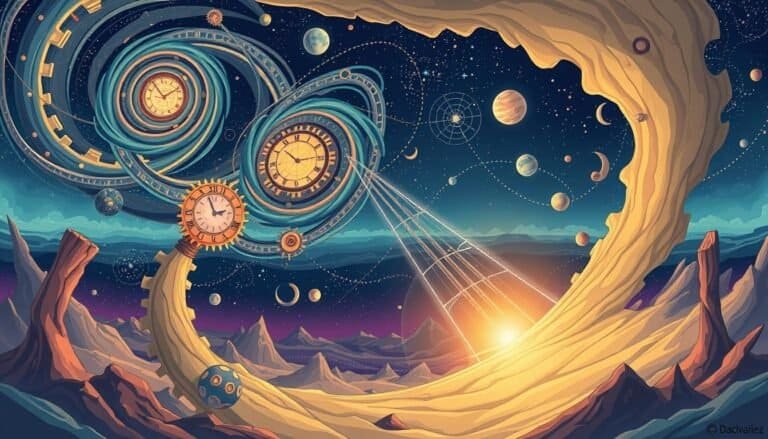Philosophy of Science: The Demarcation Problem
What if what we call “science” could actually be just another form of persuasion or pseudoscience? In the philosophy of science, we face a big issue called the demarcation problem. It’s about figuring out how to tell scientific theories from fake ones. This problem has been around for centuries, even going back to ancient philosophers like Aristotle.
Looking into the demarcation problem, we’ll see key ideas from thinkers like Karl Popper and Thomas Kuhn. Popper talked about how we can tell science from fake science by seeing if it can be proven wrong. Kuhn changed how we see science and fake science. We’ll also look at how these ideas affect science teaching and what people think, especially with topics like climate change and vaccines.
Key Takeaways
- The demarcation problem has been a big challenge for philosophers for a long time. It’s about finding clear lines between science philosophy.
- Karl Popper’s idea of falsifiability helps us tell real science from fake science.
- Studies like the Franklin Commission’s look at how science can be applied to tricky topics.
- Thinkers like Thomas Kuhn and Paul Feyerabend question traditional ways of solving the demarcation problem.
- Understanding the demarcation problem is key to teaching science well and fighting fake news.
An Ancient Problem with a Long History
The demarcation problem has deep roots in ancient philosophy. Early thinkers struggled to separate true knowledge from just guessing. Socrates, through Plato’s dialogues, talked about the need for expertise. He discussed what makes real medicine and what’s just fake.
This concern is still with us today in debates about science and fake science.
Cicero also joined the conversation. He criticized divination, showing the need to know what’s real and what’s not. He suggested five ways to tell true knowledge from false. These include:
- Logical consistency
- Empirical confirmation
- Specificity
- Arbitrariness
- Data selectivity
These ideas are still important today in understanding science and its limits. As we look back, we see how ancient thoughts still shape our views on knowledge.
| Philosopher | Contribution |
|---|---|
| Socrates | Highlighted the difference between legitimate practices and quackery. |
| Cicero | Critiqued divination and proposed criteria for demarcation. |
Understanding the Demarcation Problem
The demarcation problem aims to define the line between science and other types of knowledge. It’s key in sorting out what’s scientifically proven from what’s not. Philosophers have given us different ways to tell them apart.
Karl Popper said that a scientific idea must be testable and simple. This means science sticks to what we can see and prove. It leaves out things we can’t check.
Thomas Kuhn talked about big changes in science, not just small updates. Imre Lakatos built on Popper and Kuhn, showing how theories grow in their own settings.
Paul Thagard believes a theory is fake science if it doesn’t get better over time. This shows science must keep changing with new discoveries. It’s what makes it different from fake science.
| Aspect | Science | Pseudoscience |
|---|---|---|
| Falsifiability | Hypotheses can be tested and potentially disproven | Claims often evade tests or lack empirical scrutiny |
| Methodology | Relies on empirical evidence and reproducibility | Often based on anecdotal evidence and personal testimony |
| Adaptability | Framework evolves with new findings | Resists change even when faced with contradictory evidence |
| Community Consensus | Peer-reviewed and subject to critique | May rely on ideological alignment and followers |
Exploring the demarcation problem is ongoing. It affects healthcare and education, where knowing what’s true is crucial. By understanding these criteria, we can spot what’s truly scientific and what’s not.
The Role of Karl Popper in Demarcation
Karl Popper changed how we think about the demarcation problem in science. His work, especially “The Logic of Scientific Discovery” from 1935, introduced falsifiability as key to science. This idea challenged the old view of verificationism, popular among thinkers like Moritz Schlick and Otto Neurath.
Popper said a hypothesis is scientific if it can be tested and possibly disproved. This idea of testing and refutation is central to his philosophy. He showed the need for a clear line between science and non-science, including logic, metaphysics, and psychoanalysis.
Popper pointed out the big differences between theories, like Einstein’s and Freud’s. He stressed that a theory is scientific if it can be proven wrong by facts. This made falsifiability a key way to judge scientific claims.
Popper’s ideas changed how we see scientific research. They highlighted the importance of debate and testing in science. These ideas have shaped discussions on scientific methods and the link between probability and discovery.
| Aspect | Karl Popper’s View | Traditional View |
|---|---|---|
| Scientific Validity | Based on falsifiability | Based on verification |
| Theory Evaluation | Critical testing and refutation | Empirical confirmation |
| Boundary Definition | Demarcation between science and non-science | Inclusion of broader fields |
| Key Published Work | “The Logic of Scientific Discovery” (1935) | N/A |
This table shows how Popper’s ideas differ from traditional views. It highlights his important role in the philosophy of science.
Falsifiability: A Critical Criterion
Falsifiability is key in checking if a scientific claim is true. It’s a big part of science philosophy. Karl Popper said a good scientific theory must be tested and proven wrong if it can.
He gave examples like general relativity to show how testing theories works. This method helps us know what’s real science.
Popper believed a strong theory can be proven wrong. This makes science better and keeps it honest. Experts like Dr. Massimo Pigliucci use this idea to judge theories.
Popper argued against thinking that only proven ideas are meaningful. He said real science theories can be tested and might fail. This makes them different from fake science.
Some think falsifiability’s role is smaller today. But it’s still important in science. For example, theories like dark matter are still being tested and debated.
Understanding falsifiability helps us sort through complex scientific ideas. It’s key to figuring out what’s real in science.
Challenges to Falsifiability
The idea of falsifiability is key in science philosophy but faces many criticisms. Critics say Popper’s criterion doesn’t fully capture the complexity of science. They argue that falsifiability doesn’t always work well in real science.
Many scientific theories are hard to test because of their complex frameworks. This makes it tough to see clear differences between science and pseudoscience.
Philosophers like Willard Van Orman Quine offer new ideas. They suggest a more detailed way to look at science. Quine’s ideas focus on how theories are connected, not just on Popper’s rules.
Quine’s ideas help us see that science uses many assumptions. This makes it hard to apply falsifiability simply.
Some say the simple way to tell science from non-science is too easy. They believe it doesn’t show how science really works. This leads to talks about better ways to tell science from pseudoscience.
This debate shows we need to be flexible in science philosophy. It encourages us to think about all the things that affect science.
Thomas Kuhn’s Perspective on the Demarcation Problem
Thomas Kuhn changed how we see scientific knowledge growth. In “The Structure of Scientific Revolutions,” he talked about normal science and extraordinary science. Normal science is the everyday work of scientists under a current theory. They solve puzzles using what they already know. Extraordinary science happens when big problems can’t be solved with usual methods, leading to a new scientific change.
Kuhn’s ideas are different from Karl Popper’s focus on whether theories can be proven wrong. Popper said theories must be testable and could be disproved. Kuhn sees science as solving puzzles. He says critical talks are key when old theories don’t work anymore. This leads to new ideas and changes in science.
This view makes us think about what science really is. For example, astrology doesn’t really solve puzzles, so it might not fit Kuhn’s idea of science. His ideas make us question what defines science. By looking at both normal and extraordinary science, Kuhn adds depth to the debate on scientific inquiry.
Postpositivism and its Implications
Postpositivism offers new ideas about science, questioning the old idea of purely objective research. Thomas Kuhn’s work is key in this area, introducing the concept of paradigms. These are the main views that guide scientific work and shape what knowledge is accepted.
The idea of *inter-subjective verifiability* is central to post-positivism. It says that scientific claims must be checked by others through shared experiences. The challenge of knowing what is science and what is not is still a big issue.
Trying to tell science apart from art, technology, or religion is hard. For over a hundred years, thinkers have struggled to find clear lines between them. This has made the debate even more complex, leaving many unsure about what science is.
There has always been a debate, especially between science and religion, like over Darwin’s ideas. The Vienna Circle and Karl Popper added to the discussion with their views on empirical evidence and falsifiability. Kuhn’s ideas also played a big part, saying new ideas need to solve big problems to be accepted.
Some philosophers, like Paul Feyerabend, believe it’s hard to say what’s truly scientific. They point out that science changes and is not always clear-cut. For example, it’s hard to tell real sciences like meteorology from fake ones like astrology.
Defining Pseudoscience: A Complex Task
Trying to define pseudoscience is tricky because it involves many practices and beliefs that look like science but aren’t. It’s important to know what’s real science and what’s not. This is key, especially when talking about topics that people argue about a lot.
Some examples of pseudoscience include astrology, studying UFOs, and saying HIV doesn’t cause AIDS. Another big debate is whether vaccines cause autism. These ideas can affect what people think and how policies are made.
For a long time, thinkers and experts have tried to figure out how to tell real science from fake science. In the 1950s, some ideas about making the most money were questioned. This led to talks about how we should question even well-known ideas.
Karl Popper’s ideas about science have been very important in these discussions. He suggested ways to tell science from pseudoscience. But, his ideas aren’t perfect and can sometimes let fake science get mistaken for real.
Philosopher Larry Laudan said in 1983 that trying to define pseudoscience is pointless. But, people are still talking about it a lot now. Scholars like Imre Lakatos think it’s very important. They say knowing how to tell real science from fake is key to understanding how science moves forward.
| Pseudoscience Examples | Claims | Scientific Counterarguments |
|---|---|---|
| Astrology | Predicting personal traits and future events | Lacks empirical support; predictions are not consistently accurate |
| Ufology | Extraterrestrial visits and abductions | No verifiable evidence; explanations often based on anecdotal accounts |
| HIV/AIDS denialism | Denial of the virus causing AIDS | Overwhelming scientific consensus supports causation |
| Vaccines and autism | Link between vaccines and autism spectrum disorder | Extensive research disproves any connection |
Trying to define pseudoscience shows us that it’s not just a simple yes or no question. The lines are blurry and can change as science and society evolve. As we keep talking about it, teaching people about science is more important than ever. This helps us deal with the problems caused by fake science.
The Impact of the Demarcation Problem on Science Education
The demarcation problem makes science education tough. It affects how we plan lessons and teach different subjects. It’s key to know the difference between real science and fake science in class. This helps students understand and interact with science better.
It’s vital to have clear rules to tell real science from fake claims in school. These rules help teach students to think critically. They learn to spot trustworthy science and avoid false info.
Here are ways to improve science education:
- Incorporating hands-on activities that foster inquiry-based learning.
- Promoting discussions around controversial scientific topics to encourage critical thinking.
- Utilizing technology to access reliable scientific information and tools.
- Training teachers to recognize and navigate pseudoscience in classrooms.
Dealing with fake science is a big challenge in education. We need strong policies to teach students about real science. Schools must work hard to teach the difference between true science and fake science.
| Strategies for Enhancing Science Education | Description |
|---|---|
| Inquiry-Based Learning | Engaging students through experiments and hands-on activities to foster curiosity and understanding. |
| Critical Discussion | Encouraging dialogue on contentious scientific issues to develop analytical skills. |
| Utilizing Technology | Employing digital resources to access accurate scientific information and tools for research. |
| Teacher Training | Empowering educators with the skills to identify and address pseudoscience effectively. |
Scientific Skepticism and its Philosophical Bases
Scientific skepticism is a key movement that helps us question claims with evidence and logic. It’s vital in science philosophy, showing us how to tell real science from false claims. Today, skeptics push for a culture where we question and check facts to make sure we talk smart.
This movement wants to fight against fake science and teach us to think deeply. It says we should look at beliefs with the scientific method. This method helps us tell real science from just stories. The debate on this topic shows how hard it is to set clear rules.
Grassroots groups work for laws and education to make us all better at science. They think if we learn to think critically, we can stop believing in false things. Scientific skepticism helps us push for better science standards in all areas of life.
Current Approaches to Demarcation Criteria
Today, we see many ways to define science, moving past old rules like falsifiability. Philosophers now tackle the tough task of telling science from fake science. They consider how society and definitions change over time.
They use a mix of views to understand this complexity. This mix helps us see science in a new light.
Analysis of scientific claims is key in these talks. It looks at how outside values affect science. We must know the difference between good and bad influences on science. This is what we call the “new” demarcation problem.
It shows how biases, funding, and ethics can change science. We need to see these effects to keep science honest.
Here’s a table that shows the main ways we approach demarcation today and what they mean:
| Approach | Key Features | Implications |
|---|---|---|
| Multi-Criterial Approach | Uses many criteria to judge if science is true | This makes science more open and diverse |
| Value-Laden Science | Sees how values outside science affect it | This leads to research that is informed and ethical |
| Holistic Evaluation | Looks at data and the situation around it | This gives a full picture of science |
| New Demarcation Problem | Helps us tell apart different influences on science | It tackles the complex issues of today’s science |
These new ways of understanding science show how science and society interact. As science grows, these ideas will be key in talking about what’s right and wrong in science.
Philosophy of Science: The Demarcation Problem in Contemporary Discourse
The debate over what is and isn’t science is still a big deal in today’s world. Figuring out how to tell real science from fake science is key for making good public policy. Recently, we’ve seen a lot of talk about how science explains things and the logic behind cause and effect. But, we haven’t talked enough about what really makes science, well, science.
Issues like vaccine doubts, climate change denial, and false info during the COVID-19 pandemic have made the problem worse. This fake science confuses people and makes them doubt the truth. Unlike regular fake news, this kind of misinformation looks real but isn’t backed up by solid evidence.
Talking more about the philosophy of science can help us understand these issues better. We can use things like peer review and who’s in a scientific group to tell real experts from fakes. Philosophers like Helen Longino say that being honest and objective in science is key to making good claims.
By talking more about this, we can make it clearer what’s real science and what’s not. This helps us make better decisions in public policy. We need clear rules to deal with all the false information out there. Philosophy plays a big part in helping us tackle these modern science problems.
| Challenges to Demarcation | Description |
|---|---|
| Skeptical Challenge | Questions the very possibility of a reliable demarcation between science and pseudoscience. |
| Triviality Challenge | Argues that any criteria for demarcation will lead to trivial distinctions. |
| Mimicry Challenge | Highlights how pseudoscience can mimic legitimate science to gain public trust. |
Conclusion
The debate on what separates science from pseudoscience is complex and ongoing. It has roots in ancient times and continues to challenge us today. Thinkers like Karl Popper and Thomas Kuhn have shaped our view. They show us the need for clear rules, especially in areas like climate policy and healthcare.
Looking back, the discussion on the demarcation problem is still lively. Larry Laudan suggests finding a clear answer might be hard, pushing us to keep thinking and coming up with new ideas. This keeps the debate fresh and relevant, ensuring science stays important in public decisions.
Trying to clearly define science and pseudoscience helps us all understand better. It also supports science’s role in a world filled with false information and unproven claims. This ongoing debate is at the heart of philosophy. It guides us towards a society that is better informed and makes better choices.
Source Links
- Pseudoscience and the Demarcation Problem
- Demarcation problem
- Science and Pseudo-Science
- The Demarcation Problem
- What is the demarcation problem?
- Demarcation problem
- The Demarcation Problem and Falsifiability – PLATO – Philosophy Learning and Teaching Organization %
- Karl Popper’s demarcation problem
- Popper, Karl: Philosophy of Science
- Falsifiability and Demarcation: a Century of Misunderstood Bafflement
- A Spectrum of Scientific Rigor: Reconsidering the Demarcation Problem from a Quinean Lens
- Karl Popper
- Popper and Kuhn on Demarcation — The Garden of Ideas
- The Demarcation Problem in Science
- What is Science? Part 1: The Demarcation Problem
- Demarcation problem – wikidoc
- Kaldis_Vol-2.indb
- What distinguishes Science from Pseudoscience? (The demarcation problem) | Research Gaps
- RealClimate: The modern demarcation problem
- Science, Values, and the New Demarcation Problem – Journal for General Philosophy of Science
- The science-pseudoscience demarcation problem
- The Multicriterial Approach to the Problem of Demarcation – Journal for General Philosophy of Science
- Science vs. non-science! Why the demarcation problem is still relevant and what we can do about it
- A contextualist solution to the demarcation problem – version soumise pour accès preprint.pages







